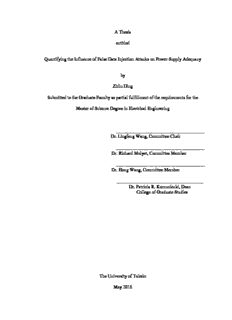
Quantifying the Influence of False Data Injection Attacks on Power Supply Adequacy PDF
Preview Quantifying the Influence of False Data Injection Attacks on Power Supply Adequacy
A Thesis entitled Quantifying the Influence of False Data Injection Attacks on Power Supply Adequacy by Zhilu Ding Submitted to the Graduate Faculty as partial fulfillment of the requirements for the Master of Science Degree in Electrical Engineering _______________________________________ Dr. Lingfeng Wang, Committee Chair _______________________________________ Dr. Richard Molyet, Committee Member _______________________________________ Dr. Hong Wang, Committee Member ______________________________________ Dr. Patricia R. Komuniecki, Dean College of Graduate Studies The University of Toledo May 2016 Copyright 2016, Zhilu Ding This document is copyrighted material. Under copyright law, no parts of this document may be reproduced without the expressed permission of the author. An Abstract of Quantifying the Influence of False Data Injection Attacks on Power Supply Adequacy By Zhilu Ding Submitted to the Graduate Faculty as partial fulfillment of the requirements for the Master of Science Degree in Electrical Engineering The University of Toledo May 2016 With the ongoing power grid modernization initiative, more cyber technologies are being deployed in the modern cyber-physical power systems. However, as a result, higher cyberattack risks will be brought about. Local load redistribution attack and unidentifiable attacks, which are two typical types of emerging false data injection attacks, could affect the outcomes of state estimation by compromising some meter measurements and thus misleading the power dispatch. Therefore, it is necessary to analyze the impact of these two types of cyberattacks on the power supply reliability. Here an optimal strategy for constructing the attack vector is studied. The procedure for incorporating the unidentifiable attacks and local load redistribution attacks into the power system reliability assessment framework using Monte Carlo Simulation is proposed. Simulation studies are conducted based on the IEEE 14-bus system. According to the simulation results, it is found that the long-term reliability of the power system could be impacted by the potential cyberattacks if they occur frequently. This study could provide some useful insights into the cybersecurity study of smart grid. iii For my parents and friends iv Acknowledgements First, I would like to express my sincere gratitude to my advisor Dr. Lingfeng Wang for his continuous support, professional guidance and great patience for me. His insightful mentorship helped me understand the problem more clearly and come up with the solution more quickly. Without his advice and encouragement, I could not have completed this work. I would like to thank the funding agency for this project. This work was in part supported by the National Science Foundation (NSF) under Award ECCS1128594. I would also thank my committee members Dr. Richard Molyet and Dr. Hong Wang for their commitments to serving on this committee from their busy schedules. I would take this opportunity to express my great thanks to Yichi Zhang, Yingmeng Xiang, Jun Tan, and all the other lab members, for their advice and discussions about my research and for their help on my life at the University of Toledo. Last but not the least, I would like to thank my family. Without their constant support, encouragement and understanding, it would not have been possible for me to achieve the educational goals. v Table of Contents Abstract……………………………………………………………………………….iii Acknowledgements……………………………………………………………………v Table of Contents……………………………………………………………………..vi List of Tables………………………………………………………………………..viii List of Figures………………………………………………………………………...ix List of Abbreviations…………………………………………………………………..x 1 Introduction………………………………………………………………………..1 1.1 Smart Grid…………………………………………………………………1 1.2 Cyber Security in Smart Grid……………………………………………...4 1.3 The Objective of Thesis……………………………………………………8 1.4 The Outline of Thesis……………………………………………………...9 2 Related researches………………………………………………………………..10 2.1 Power System State Estimation…………………………………………..10 2.2 False data injection attacks……………………………………………….13 2.3 Power System Reliability………………………………………………...16 3 Problem formulation……………………………………………………………..20 3.1 Local load redistribution attacks………………………………………….20 3.2 Unidentifiable attacks…………………………………………………….28 3.3 Power System Reliability Modeling……………………………………...32 3.3.1 Power System Reliability Modeling……………………………...32 vi 3.3.2 Power System Reliability Modeling……………………………...36 4 Simulations Results and Analysis………………………………………………...41 4.1 System Parameters and Configuration…………………………………...41 4.2 Local LR Attacks Incorporated into Power system Adequacy…………..43 4.3 Unidentifiable Attacks Incorporated into Power system Adequacy……...46 5 Conclusion and future work……………………………………………………...52 5.1 System Parameters and Configuration…………………………………...52 5.2 Local LR Attacks Incorporated into Power system Adequacy……………53 References......................................................................................................................54 vii List of Tables 1.1 The Comparison Between the Traditional Grid and Smart Grid…………………………2 4.1 Generation Parameters………………………………………………………………………..41 4.2 Transmission Line Parameterss……………………………………………………………...41 4.3 Partial Results for the First-Order Contingency…………………………………………..43 4.4 Simulation Outcome for System Adequacy with Local LR Attack ……………………44 4.5 Compromised Measurements and Eliminated Measurements…………………………..46 4.6 Unidentifiable Attack and Undetectable Attack…………………………………………...46 viii List of Figures 1-1 The possible reasons for cyber security issues in smart grid…………………………..5 3-1 Local load redistribution attack scheme……………………………………………..21 3-2 The bilevel model for the local LR attack……………………………………………22 3-3 Flowchart for selecting meaningful attack regions………………………………….26 3-4 Consideration of local LR attack in adequacy assessment…………………………...34 3-5 Framework for power system adequacy incorporating the local LR attack…………36 3-6 Flowchart for power grid reliability considering unidentifiable attacks……………..39 4-1 Modified IEEE 14 bus system……………………………………………………….40 4-2 Probabilities of attack regions for system state with line 4-5 failure………………..43 4-3 Influence of the number of attacks on system reliability……………………………..48 4-4 Influence of the attacks magnitude limit on system reliability……………………….48 4-5 Influence of compromised measurements on power system reliability………………49 ix List of Abbreviations AMI……………………………………….. Advanced metering infrastructure CAIDI…………………………………….. Customer Average Interruption Duration Index CAIFI…………………………………….. Customer Average Interruption Frequency Index EENS…………………………………….. Expected Energy Not Supplied EMS……………………………………… Energy Management System HMI……………………………………… Human machine interface KKT……………………………………… Karush–Kuhn–Tucker LOLE ……………………………………. Loss of Load Expectation LOLP……………………………………… Loss of Load Probability LR………………………………………… Load Redistribution MCS………………………………………. Monte Carlo simulation MTTF…………………………………….. Mean Time to Failure MTTR……………………………………. Mean Time to Repair MTUs…………………………………….. Master Terminal Units NERC……………………………………. North American Electric Reliability Council NIST……………………………………... National Institute of Standards and Technology OPF………………………………………. Optimal Power Flow x
Description: